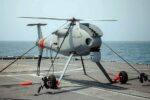In a notable shift in its Indo-Pacific aviation posture, the U.S. Marine Corps has temporarily replaced its forward-deployed F-35B Lightning II stealth fighters with legacy F/A-18 Hornet aircraft at Marine Corps Air Station (MCAS) Iwakuni, Japan. The rotation is part of a broader force generation and modernization cycle under Force Design 2030 and reflects evolving operational priorities across the region.
Background: MAG-12 and Forward-Deployed Aviation in Japan
Marine Aircraft Group 12 (MAG-12), part of the 1st Marine Aircraft Wing (1st MAW), operates from MCAS Iwakuni as the primary forward-deployed USMC aviation element in the Western Pacific. Since January 2017, VMFA-121 “Green Knights” became the first operational squadron to deploy the short takeoff/vertical landing (STOVL) F-35B outside the continental U.S., replacing their legacy Hornets at Iwakuni.
The deployment of fifth-generation fighters to Japan was seen as a key milestone in enhancing regional deterrence against near-peer threats such as China and North Korea. The aircraft’s low-observable profile, advanced sensor fusion capabilities via AN/APG-81 AESA radar and DAS/EOTS systems, and ability to operate from amphibious assault ships or austere bases made it central to Expeditionary Advanced Base Operations (EABO) concepts.
The Swap: From Stealth Back to Legacy
As of September 2025, VMFA(AW)-225 “Vikings,” operating two-seat F/A-18D Hornets from MCAS Miramar under MAG-11/3rd MAW, have deployed to Iwakuni on a rotational basis. This marks a temporary backfill while VMFA-121 undergoes stateside training cycles and aircraft maintenance upgrades.
The USMC clarified that this is not a permanent reversal but part of routine force generation processes. The shift allows for depot-level maintenance on forward-deployed aircraft while maintaining continuous fighter presence in theater. The F/A-18Ds retain multi-role capabilities including air-to-air combat with AIM-120 AMRAAMs and air-to-ground strike using JDAMs or LGBs—though without the stealth or sensor fusion advantages of the F-35B.
Operational Implications for Indo-Pacific Deterrence
While some observers may interpret this rotation as a capability downgrade due to the generational gap between platforms, USMC planners emphasize that readiness cycles are essential for long-term sustainability. Moreover:
- Persistent Presence: The presence of any fixed-wing tactical squadron at MCAS Iwakuni maintains deterrence messaging toward regional adversaries.
- Training Continuity: MAG-12 continues joint training with Japanese Self Defense Forces (JSDF), including bilateral exercises such as Kamoshika Wrath and Keen Sword.
- EABO Compatibility: While less optimized than STOVL jets, legacy Hornets can still support distributed operations from island bases with appropriate logistics support.
This temporary substitution also reflects lessons learned from high operational tempo deployments since FY2017—wherein forward-based squadrons faced accelerated wear rates on low-density assets like the F135 engine powering the F-35B.
Tied to Force Design 2030 and Aviation Modernization
The rotation aligns with broader restructuring under Force Design 2030, which calls for lighter expeditionary units capable of rapid deployment across contested maritime terrain. As part of this vision:
- The USMC is reducing heavy armor units while investing more heavily into unmanned systems (e.g., MQ-9A Reaper ISR/strike drones).
- Aviation components are being reshaped around survivability and distributed lethality—making periodic withdrawal for upgrades essential.
- The service is integrating MUM-T (Manned-Unmanned Teaming) concepts where legacy platforms like Hornets can still contribute via networked kill chains involving sensors like G/ATOR radars or HIMARS launchers linked via C2 nodes such as CAC2S.
Japan-US Alliance Dynamics Remain Unchanged
Japanese defense officials were reportedly briefed ahead of time regarding the rotation plan. According to statements by Japan’s Ministry of Defense (MOD), they view this as a normal part of allied force posture management rather than any degradation of commitment or capability.
This comes amid Tokyo’s own modernization efforts—including procurement of over 100 F-35A/B variants for both JASDF and JMSDF use—and increased defense spending aimed at countering Chinese maritime expansionism around Okinawa and Taiwan Strait corridors.
Conclusion: A Strategic Pause Rather Than Regression
The temporary replacement of fifth-generation fighters with fourth-generation platforms in Japan does not signal retreat but rather reflects deliberate force management within high-demand environments. Maintaining high readiness rates for advanced platforms like the STOVL-capable F-35B requires periodic cycling through depot maintenance phases—a challenge exacerbated by limited global sustainment capacity for newer fleets.
If anything, this move underscores how seriously USINDOPACOM treats long-term sustainability over short-term optics—ensuring that when next deployed forward again, VMFA squadrons will be fully mission capable across all domains.









